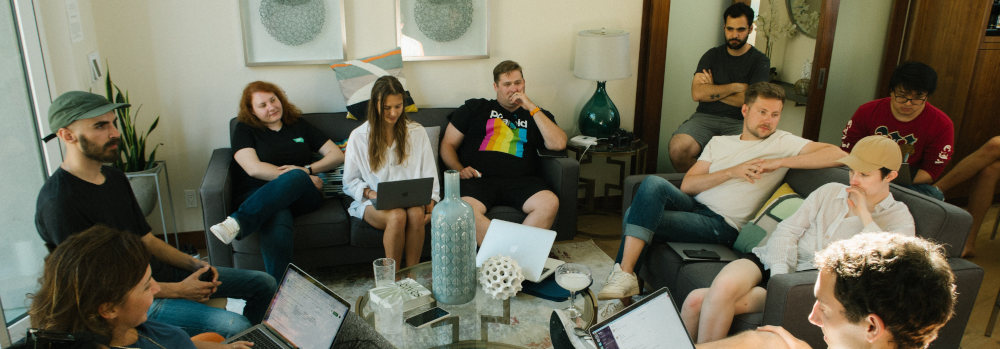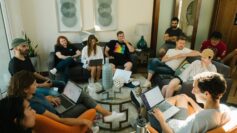How far on the way to community can a group get in 90 minutes? A field report for a taster session with "Community Building by Scott Peck".

Community Building by Scott Peck is a method to train intuition, authenticity, conflict resolution skills and awareness as well as practically exploring the building of a trust relationship within a group. The community building process happens mostly unguided. The focus is to get in contact with each other authentically and to see each other on the emotional level, to examine the barriers of communication, resolve them and try to achieve community within a group of people unknown to each other. The special feature here is, that the experiences which are arising are far more surprising and extraordinary than one possibly could assume.
Taster session Community building of the
"Network Frankfurt for joint forms of living"
As the name "Community building" is expressing, the method may provide very important insights for emerging or already existing communities. That's why "Network Frankfurt for joint forms of living" organized a 3 hour taster session "Community Building by Scott Peck" last Wednesday evening. This has been already for the fourth time so far. Birgit Kasper (Leader Network Frankfurt) and Tabea Kayser (Public Relations Network Frankfurt) also participated at the process. Fortunately, the session was offered free of charge and with 30 people present, the topic seems to be very interesting for a lot of people. At the rope factory - a place for creativity and diversity in Frankfurt - mostly mature people gathered together to dive into this community building. Sandra Schinke (47, traumasensitive personal/relationship trainer and graduated engineer) [1] as well as Tobias Unsleber (45, IT-Administrator and Community Building Facilitator) [2] facilitated this event.
The start of the evening
After welcoming the participants everyone had the possibility to express how she or he is feeling right at the moment. Then we gave some short informations about M. Scott Peck (1936-2005), the main inventor of the method, about the essence of true and authentic community and of course the only things that the participants are given to explore the process: The process guidelines along with some short explanations. For a taster session, we use a reduced set of guidelines compared to those in a full workshop.
The guidelines
- Say your name, before starting to speak
- Speak, when moved to speak. Do not speak when not moved to speak.
- Welcome Everything: Thoughts, body sensations and feelings, positive and negative
- Use I / my statements
- Voice displeasure within the whole group
- Take a risk!
Some of the guidelines are absolutely not self explanatory. Figuring out, what the guidelines mean is the task of the group.
Just before the process, the facilitation had been reading the story The Rabbis Gift and then - after 5 minutes of silence - the journey into the unknown began with the words "Those, who are moved to speak, may speak now!"
The Process
The group started quite lively and had been staying that way for a while. Reflections about the story were shared. And - as expected to us - the sharings about it are different from other sharings heard so far in the past because every human being is different. The group embraced the guideline "voice displeasure within the whole group" quite quickly. The stumbling block is immediately there: A window is offering voluntarily its service for that task or more precisely said: A person daring to close the window without asking the group if allowed to do so. Should it stay open or be closed? Is the disturbing draft more important than the impaired ability to listen to the process because of the nearby airport? Outrage about not being asked about for the opinion on this topic on one side and in response to that outrage about missing independence in taking responsibility for one's own needs. Many of the group participated in voicing displeasure. Displeasure is also expressed for other topics. And after a while the atmosphere suddenly changed considerably to a frisky cheerfulness. The displeasure was expressed and received by the group - without resistance. Many had expressed or dumped their displeasure and anger into the middle of the group and after that the anger was just gone - like taking out heavy stones of ones backpack and feeling a lot lighter on the following journey. As a consequence of the window topic some people just changed places with others from the group as needed. No big deal anymore.
The process continues. Experiences are made, shared and from time to time insights mentioned about the running process: "Listening is really important!", "At the beginning of your sharing, I was deep in contact with you. Later it was no longer there.", "Somehow it seems we lost the intensity in the last couple of minutes.". Regularly a certain depth in the sharings is palpable, far from what is shared between persons in daily life. But here it is - between strangers. A special feature of the process is, that there's not one topic to which all contributions have to be restricted to. The guideline to speak when moved to causes that the topic may change at any time and sharings strictly staying on topic but boring the audience and even the speaker more and more cease to be made. After some time the atmosphere is getting tenacious and lesser energetic. We - the facilitators - have some clear clues of what this is caused by. But it is not our task to possibly help by communicating our guesses. We share our thoughts only after the process had ended: The group seemed to be bored by certain kinds of sharing - being uneasy with that and unsure how to respond to that - and so reacted not at all.
After the only hint from the facilitation at this event, the group was still not able to resolve the reason for the tenacious atmosphere and the time was running out. Some participants already switched to reflections of the event. Maybe this was the easier task than to stick to the uneasyness present in the group. After about 90 minutes, the time of the process is up.
The facilitation
The task of the facilitation is a very retentive one. The patterns of action in group processes like this are clearly perceivable with enough practice - and also with some negative emotional effects those patterns may cause sometimes within the facilitators. But the task of the facilitation is not to protect the participants from negative emotions. No. It's the exact opposite: Protecting would detain the participants from valuable experiences. The experience of cause and effect. What causes pain and what causes joy? In other words - like the official objectives description from the federation of community encouragement tells it: Figuring out barriers of effective communication and resolving them. My own inner reactions when observing the process where quite diverse: On one side maybe an annoyed moaning or a joyful delight and on another side a curious smirking smile while wondering how the group will respond to a certain situation.
The facilitation only shares hints and only if the group is not successful to detect and respond adequately to a situation or a pattern repeatedly. Normally facilitators exchange within the facilitor group in a weekend workshop in the breaks on what is going on within the group, if there are any hints they want to give to the group and how to communicate those hints. Due to the limited time of a taster session, this is done here spontaneously. And also here there's a special way to give those hints: There are no clear orders on how to act or handle the situation. It's only a support for the whole group to explore their feelings, helping to figure out what the problem is for themselves. The only help, we provided for this evening event was this:
How do you feel right now? What does the guideline "Speak only, when moved to speak!" mean? What sharings were in harmony with this guideline and what sharings where not? Did everyone of you speak only when moved to speak?
One could - of course - give precise orders: Stefan, you should talk more like this and that! Lisa, please talk less! Matthias, you're not participating at all. Come on! Jump in! Andrea, please use I-Statements! etc. That seemingly might work quite well, but real learning is more effective, when participants work it through for themselves. The sense of this community building is, that participants train their awareness for themselves and not just copy the facilitators actions. At the latest, if faced with new, unknown and difficult situations, then the repetition of just memorized patterns of action to seemingly the same situations maybe absolutely unhelpful. In opposite a sharp awareness supports to fully understand a situation and is therefore precondition to act adequately.
The end of the evening
After closing the process, the group got a break to relax. Some of the group directly left. The rest of the party took some more time with reflections on the past evening. We as facilitators shared our perceptions of the sessions. What special situations had happened? Written manuals are handed out to anyone interested in diving more into the topic of community building.
Bottom Line
The taster session was a really successful event for us, because every participant was involved and seemingly really got some piece from this new world. Above all the group learned, that the expression of displeasure does not have to end in a catastrophe but may also lead to serenity and joy. The attendees have experienced - in different grades - the special setting of this method. I myself recognized with some satisfaction the amazement of the group when actually experiencing this new thing - also by beginning to collectively unlocking their power as a group. I'm happy the group could enjoy the results of their hard work as feelings of vitality, joy and connectedness.
Update at 2023/8/6
A little addition: Some of you readers may wonder: A conflict about an open window? Are you serious? That should make up the big battles of community?
Surely not! Of course a discussion about an open window is chicken feed. But the way of handling this very little conflict is a first step on the way to mastering conflict resolution in community building style. There definitely will be a lot more and a lot more difficult conflicts. The intensity and the energy within the group rises with the level of what is at stake. And sky is the limit!
[1] Sandra Schinke – https://www.beziehungsart.net
[2] Tobias Unsleber – https://gemeinschaftsbildung.space
[3] Federation for Community Encouragement (FCE) https://www.fce-community.org/
Handout (German only) for the taster Session "Community Building by Scott Peck" online available at:
https://nextcloud.megabert.de/index.php/s/a495HHsD6567x8i

